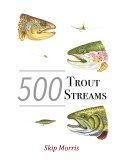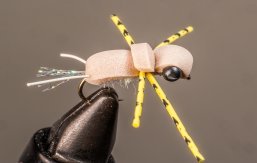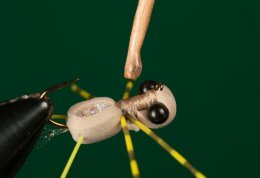The Truth About Chironomids
Part Two
by Carol Ann Morris
(originally published in Fly Fishing
and Tying Journal, Spring 2006)
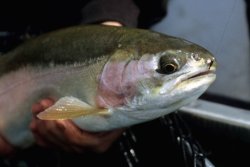 A large Kamloops rainbow trout that fell to a
A large Kamloops rainbow trout that fell to a
Chironomid pupa fly in the famous lakes
of British Columbia.
In this article, The Truth About Chironomids Part Two, the popular "quick-strip technique" for fly fishing with Chironomid imitations is discussed in detail.
In the previous article, The Truth About Chironomids Part One, Carol discusses some truths about fishing deep with Chironomids.
Because Chironomids are ranked as one of the most important sources of food for trout in lakes, it is important to understand their biology and behavior. In The Truth About Chironomids Part Three, the details about the life cycle and unique characteristics of Chironomids are revealed, and three hot chironomid pupa patterns recommended by the experts are introduced.
The Quick-Strip Technique:
Fly Fishing Deep and Fast
with Chironomid Pupa Imitations
Both the standard indicator technique and newer quick-strip technique use the same basic equipment:
Floating line, strike indicator, and weight on the leader or a bead-head fly.
The quick-strip technique was developed by guide Peter Morrison and fly shop owner Kelly Laatsch, both from the St. Mary Angler Fly Shop (www.stmaryangler.com; 1-800-667-2311), and is fished as follows:
- Determine the depth of the lake where you are fishing (see the section on "How Deep Do You Go?" later in this article to help you determine lake depth), and position the strike indicator so the fly is suspended one to two feet off the bottom of the lake.
- Use a bead-head Chironomid pupa imitation or place split shot or putty weight ten to twelve inches above the fly. Either of these options work equally well. Use a knot in the tippet to hold the weight in place.
- Cast the fly directly downwind from the boat.
- Wait about one minute for the fly to sink down into the strike zone, one to two feet off the bottom of the lake. It is best to time it so you are sure that the fly is deep enough.
- With the rod tip on the lake's surface, and the line taut, make four to five quick strips with the line. The strike indicator should make a wake on the surface, and travel two to three inches per strip. Wait ten seconds between each set of strips.
- Be sure to work the fly right up to the boat; it isn't unusual to get a strike right next to where you are anchored, since the trout often follow the fly.
Peter has seen a number of fishermen pick up their line too soon, and miss strikes. He also notes that it isn't important to cast out a long distance from the boat, since most fish are caught within an easy cast right around the area where you are anchored.
The theory behind this quick-strip technique is that the animated movement of the fly made by consistent, sharp strips of the line,
causes trout to
strike instinctively.
How Deep Do You Go?
Determining the Depth of a Lake
Peter also gave us a tip for determining the depth of a lake—clamp a hemostat to the hook bend (just one click, if you clamp down more,
the hook might break), and then lower the fly to the lake floor.
When it touches the bottom the line goes slack. Move your strike indicator so that the fly floats one to two feet off the lake bottom.
Leave the hemostat on the hook, adjust the indicator, and keep testing until it is positioned where you want it. Then remove the hemostat, and you're ready to make your first cast.
Strike Indicators...Which Ones Are Best?
We prefer to use corkies for strike indicators. They are easy to move once they're placed on the leader, and they won't get water-logged.
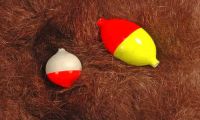 An example of two different sizes
An example of two different sizes
of corkie strike indicators.
Many avid chironomid fishers now prefer
the larger indicator on the right.
We use mainly the smaller sizes, half an inch in diameter, but Brian Chan, British Columbia's fisheries biologist for over 25 years and an expert
on Chironomid fishing, has suggested using larger ones instead.
The larger size floats consistently on the surface, and wave action moves the fly in a way that mimics the natural.
Subtle takes by trout will be harder to see with a larger indicator, however, so both sizes are worth considering.
How Do They Compare?
A Look at the Standard Indicator Method
vs.
the Quick Strip Technique
Standard Indicator Method
- 1. Determine the depth of the lake where you are fishing, and position the strike indicator so that the fly is floating one to two feet off the bottom.
- 2. Cast the fly at a right angle to the wind.
- 3. Wait for the fly line (and fly) to drift until it is directly downwind from the boat.
- 4. Once the line has completely straightened out downwind, start a very slow retrieve with pauses, barely moving the indicator.
- 5. When the indicator nears the boat, pick up the line and cast it out again.
Quick Strip Technique
- 1. Determine the depth of the lake where you are fishing, and position the strike indicator so that the fly is floating one to
two feet off the bottom.
- 2. Cast the fly downwind from the boat.
- 3. Wait one minute for the fly to sink into the strike zone, one to two feet off the lake bed.
- 4. With the rod tip on the lake's surface, and the line taut, make four to five quick strips of the line.
- 5. The strike indicator should make a wake on the surface, and travel two to three inches with each strip. Wait 10 seconds between each
set of four to five strips.
- 6. Work the fly right up to the boat, where trout often strike, before you pick up the fly to recast.
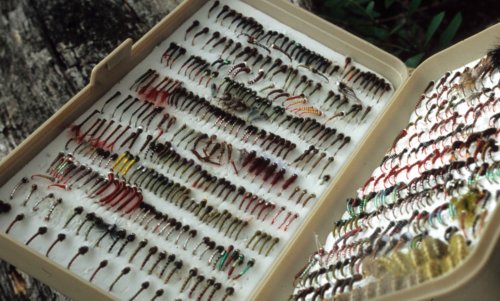 Most serious lake-fishers carry at least one fly box like this nowadays...
Most serious lake-fishers carry at least one fly box like this nowadays...
full of chironomid pupa patterns.
In the last segment of this article, The Truth About Chironomids Part Three, the major characteristics, life cycle, and behavior of Chironomids are discussed to help you understand why these insects are one of the most important sources of food for trout in lakes. It concludes with three hot chironomid pupa patterns recommended by the experts.
Click here to hear Skip's interviews on popular podcasts...
*Announcements*
Skip has an essay in Big Sky Journal's annual Fly Fishing issue, called "Montana Hoppers: the Princess and the Brute" released February 1, 2023. Skip rewrote it a bit; I painted and illustrated it here, on our website. Here's the link on our web page to check it out:
Click here to read Skip's essay Montana Hoppers: The Princess and the Brute...
Skip's latest books:
Top 12 Dry Flies for Trout Streams: How, When, and Where to Fish Them, is now available on Amazon as an ebook...check it out! Click on the links below to go to the information page on Top 12 Dry Flies (the link to Amazon is at the bottom of the page...)
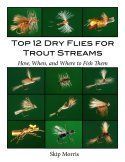 Top 12 Dry Flies for Trout Streams: How, When, and Where to Fish Them
Top 12 Dry Flies for Trout Streams: How, When, and Where to Fish Them
Click here to get more information about
Top 12 Dry Flies for Trout Streams: How, When, and Where to Fish Them (the link to Amazon is at the bottom of the page)...
Top 12 Dry Flies for Trout Streams: How, When, and Where to Fish Them (the link to Amazon is at the bottom of the page)...
Top 12 Nymphs for Trout Streams: How, When, and Where to Fish Them, 2nd Edition, originally published as an e-book only, is now available on Amazon as a paperback...check it out! Click on the links below to go to the information page on Top 12 Nymphs (the link to Amazon is at the bottom of the page...)
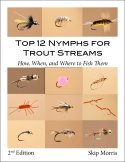 Top 12 Nymphs for Trout Streams: How, When, and Where to Fish Them (2nd Edition)
Top 12 Nymphs for Trout Streams: How, When, and Where to Fish Them (2nd Edition)
Click here to get more information about
Top 12 Nymphs for Trout Streams: How, When, and Where to Fish Them (2nd Edition). . .
Top 12 Nymphs for Trout Streams: How, When, and Where to Fish Them (2nd Edition). . .
Click here to get more information about Skip's e-book,
500 Trout Streams...
500 Trout Streams...
Skip's latest paperback book:
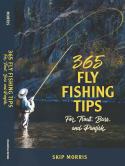 365 Fly Fishing Tips for Trout, Bass, and Panfish
365 Fly Fishing Tips for Trout, Bass, and Panfish
Click here to get more information about Skip's latest book,
365 Tips for Trout, Bass, and Panfish...
365 Tips for Trout, Bass, and Panfish...
Print Skip's chart for FREE:
Skip Morris's Trout-Fly Proportion Chart
Go to Skip Morris's Trout Fly Proportion Chart
Skip's Predator is available to buy...
Skip's ultra-popular Predator—a hit fly for bluegills and other panfishes and largemouth bass (also catches smallmouth bass and trout)—is being tied commercially by the Solitude Fly Company.
The Predator
CLICK HERE to learn more about or to purchase the Predator...
Learn to Tie Skip's Predator
Do you want to tie the Predator?
Tying the Predator
Skip shows you how to tie it on his YouTube Channel link, listed below:
CLICK HERE to see Skip's detailed video on how to tie the Predator...






